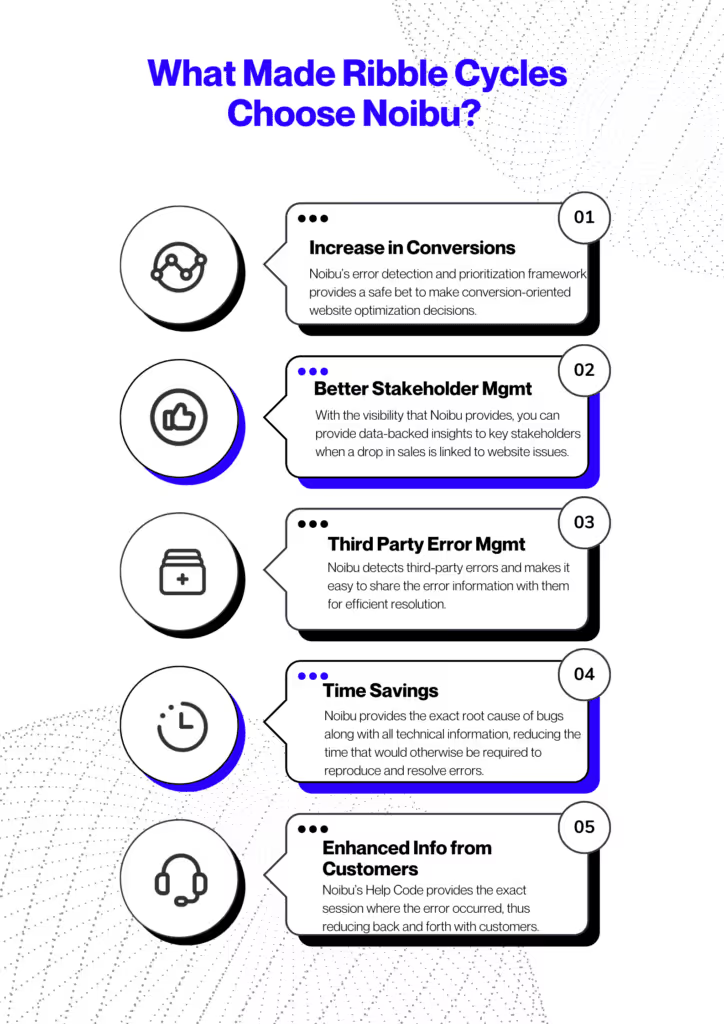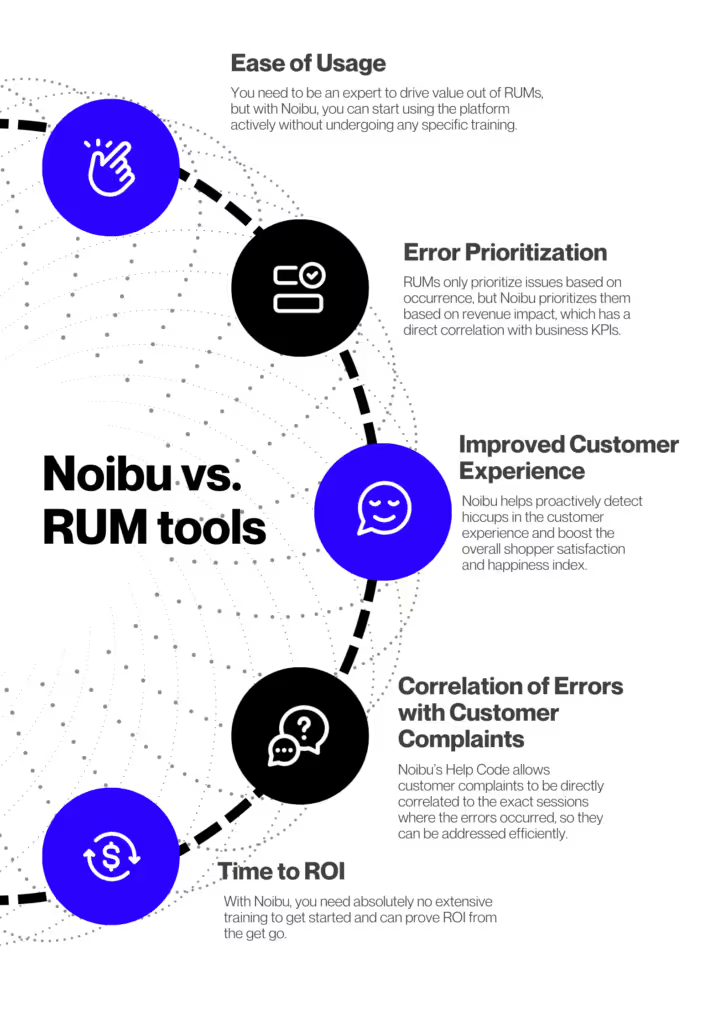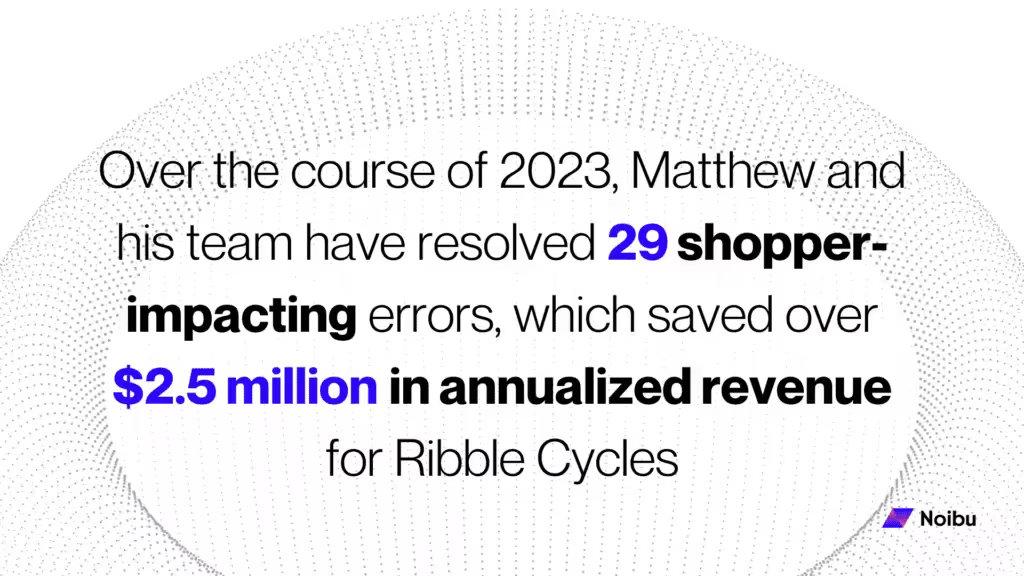How Ribble Cycles transformed their ecommerce monitoring and drove positive ROI with Noibu

Established in 1897 and known for its world-class range of bikes that are expertly designed and hand-assembled, Ribble Cycles is one of the UK’s biggest online bike dealers.
Matthew Lawson is the Chief Digital Officer at Ribble Cycles, leading the legacy brand’s digital transformation efforts by strengthening their eCommerce and omnichannel presence.
Matthew and his team have been using Noibu for their ecommerce monitoring efforts since July 2020. So, to learn more about what their experience has been like, we recently sat down with Matthew to get his perspective on Noibu’s capabilities.
In this case study, we will break down how Matthew discovered Noibu, what made him choose Noibu over other similar tools, and how he compares the platform to a popularly known real user monitoring tool from his team’s tech stack.
What was the key challenge Matthew was looking to address when he discovered Noibu?
Back in 2020, when Matthew was looking to add a tool to his visibility stack, he was already using New Relic, Google Analytics, and other tools to analyze user experience on the website. However, with such tools, even though he knew that they would yield some insight, he had to examine lots and lots of data, but the real question remained whether that data would translate into meaningful actions that could move the needle in terms of site performance.
Another challenge Matthew pointed out was that these tools are a time sink. If he would invest loads of time into the tool, he would surely end up discovering some insight. However, what he was looking for was a platform that would help his team prioritize and focus on site errors that had a tangible impact.
Therefore, initially, Noibu resonated with Matthew because of the prioritization of site errors based on the impact that they have on revenue. This game-changing functionality helped him make data-informed decisions on whether an error is worth investigating and addressing or not.
Ribble Cycles’ error detection and resolution workflow before using Noibu
The error detection workflow that Matthew and his team followed before Noibu was fairly conventional. His team would learn about site errors in one or more of the following ways:
- Customer service representatives would flag issues reported by customers
- Regular testing would detect errors that require attention
- Senior leadership would pinpoint errors that needed immediate resolution
- Business meetings where it is brought up that sales are down and the reason could be the website
Matthew’s team would then spend their time investigating the issue, trying to replicate it, looking into GA, and very often, asking for further information to ensure a satisfactory resolution. Eventually, the noise would dissipate and it would be business as usual, without a proper fix being implemented to ensure that the error doesn’t pop up again.
What made Ribble Cycles choose Noibu and what are some of the biggest wins they had with the platform?
Matthew adds that the reason why he bought Noibu is different from the reason why he continues to use the tool so heavily today.
Interestingly, during the trial period when Noibu’s tag was deployed on Ribble Cycle’s website, our team was able to discover a critical error on the payment getaway, which if left unaddressed, could have led to significant revenue loss.
“The revenue that Noibu helped save actually covered the cost of the tool for the first year.”
So, choosing Noibu was a quick and easy decision based on the first impression and the huge win that Matthew and his team had during the trial period.
Here are some of the biggest wins Ribble’s eCommerce team had with Noibu so far:

Increase in conversions
Over the course of the next few sprints, Matthew’s team addressed a few more revenue-impacting errors that Noibu discovered and saw a roughly 4% increase in conversions, which is sizeable for a business the scale of Ribble Cycles.
Matthew quickly realized that Noibu’s error detection and prioritization framework provided a safe bet in terms of making website optimization decisions that are more likely to give his team a conversion win right away, as opposed to A/B testing.
Better stakeholder management
With Noibu, Matthew has been able to better manage instances where his team is required to address changes in business KPIs among leadership and other key stakeholders.
Now, when issues with low sales are linked to the website, Matthew can quickly look at the Noibu dashboard to discover if any new errors have shown up lately, sort them by impact and frequency of occurrence, and address them then and there.
“I can now address that issue in 30 seconds with Noibu that used to take me 3 days earlier”
So, with the source of the bug clearly stated and all the technical information related to the bug readily available, his team now is able to efficiently resolve the issue, even within a code base that consists of millions of lines of code.
Improved control over errors due to third-party elements
There was a time when Matthew put a code freeze on his website and even with his team not editing a single line of code, third parties ended up introducing a series of completely unanticipated errors.
From browsers deprecating features to the payment gateway causing bugs to the live chat malfunctioning, the website was loaded with third-party errors, that Noibu was able to detect.
Matthew especially appreciates how easy it is to share the particular error information with the required third party instead of giving them complete access to Noibu’s dashboard.
“Normally, you’d lose a lot of time and all your patience going back and forth with third parties whenever an issue occurred. With Noibu, it was quick and simple where I shared a piece of code with the third party and they came back with the probable cause and the date by which it was going to be rectified and released – and it was done!”
Another instance Matthew recalls was when his A/B testing tool broke down on Safari and Firefox, and Noibu helped him discover the issue. He was able to exit the contract without a penalty because of the evidence he was able to show with Noibu.
Because of the visibility that Noibu provides, Matthew and his team have been able to cut down a lot of back and forth that would otherwise occur whenever the slightest issue with the website would arise, even if it involved a third party.
Time saving and efficiency
Earlier, when an error was brought to Matthew’s attention, he would lose several hours of his dev hours trying to investigate and replicate the bug. However, with Noibu, Matthew has been able to quickly log in to the dashboard, find the root cause, corresponding user session, and all technical details required to make the fix, thus significantly boosting his team’s error resolution efficiency.
Elimination of back and forth with customers
With the help of Noibu’s Help Code, Matthew has been able to drastically reduce the back and forth that often used to happen with customer service representatives as well as customers trying to find the corresponding session to the error.
With Noibu, customers can record their unique help code within the support ticket, making it a breeze to align complaints to user sessions. This again helps Matthew’s team save time by resolving errors efficiently and avoiding any distractions for developers.
“When we did a major site migration, conversions dropped for a few days. I probably still think that we’d have problems with the checkout if it wasn’t for the visibility that Noibu has brought to us.”
Noibu vs RUM tools: How Ribble Cycle compares Noibu to other similar tools in Matthew's team’s tech stack?
When comparing Noibu to the real user monitoring tool that his team had been using, Matthew highlights the following differences he noticed:

Ease of ssage
According to Matthew, you need to be an expert to get value out of the RUM tool, but with Noibu, you can start using the platform actively without undergoing any specific training. With the RUM tool, you get a lot of data, numbers, and graphs, but you must be well-versed with it to be able to derive actionable insights from it.
When comparing Noibu with digital experience analytics tools that offer find-and-fix solutions, Matthew added that later do not provide any in-depth insights the way Noibu does.
Prioritization of errors based on revenue impact
With other RUM tools that prioritize errors based on occurrence, Matthew’s team would often address all critical issues, but the question remained – do they actually have an impact on the revenue? However, the issues prioritized by Noibu based on revenue impact had more correlation with improvement in site performance and business goals.
“With Noibu, it’s like running guaranteed A/B tests with the probability of delivering a positive result being infinitely higher when utilizing the data presented by Noibu.”
Improvement in customer experience
Apart from highlighting errors based on revenue impact, Matthew commends Noibu’s ability to help proactively detect hiccups in the customer experience and boost the overall shopper satisfaction and happiness index. Sometimes, errors may have a direct impact on brand perception or user experience that may, down the road, lead to a revenue impact. Noibu simplifies discovering such errors that might be leading to a loss of users across the funnel.
Correlation of customer complaints to actual errors
With Noibu, Matthew can utilize the Help Code provided along with support tickets to find errors, add complaints to Jira, and also tag the customer service representative who raised the issue so that they are notified and updated whenever it’s fixed.
“Noibu facilitates this full-circle communication with customer service and this automated communication is what’s game-changing about this workflow.”
This way, customer service is more likely to raise error tickets as they receive regular updates about their raised issues and are able to track progress.
Time to ROI with Noibu vs RUMs
Matthew adds that it’s really hard to prove that you’re driving tangible ROI with the RUM his team uses. In his own words, it’s like buying a Ferrari and driving it at 30 miles/hour as the tool requires a lot of training, expertise, and a dedicated user to get the maximum benefit out of it.
“Noibu wins hands down when it comes to being able to prove a win and measure ROI. Also, there’s no administration, training is relatively light, and you don’t have to maintain it all the time – it’s just more usable, which is why it stuck.”

Ribble Cycles has been a loyal customer for years now and this case study is an excellent example of the significant ROI that Noibu is capable of driving in the long term by streamlining entire eCommerce monitoring workflows.



